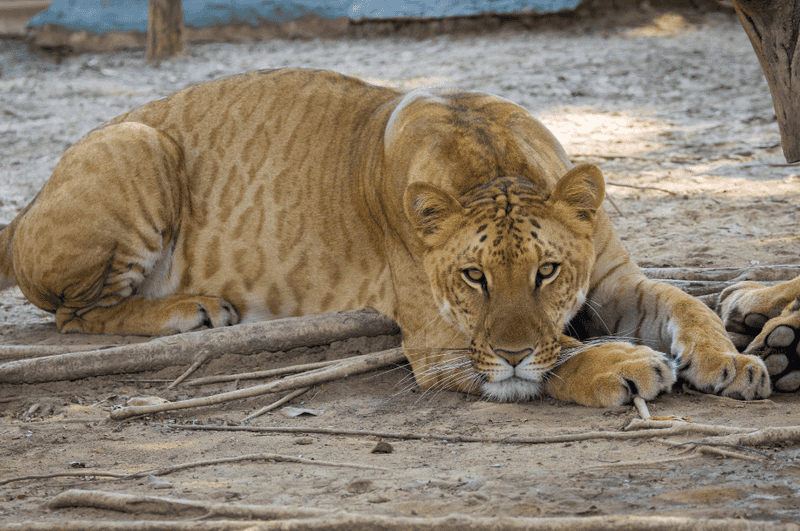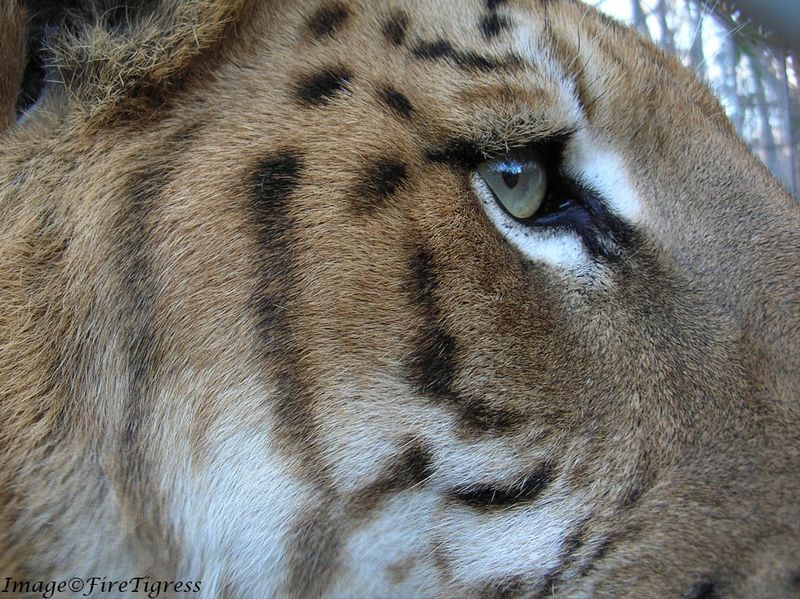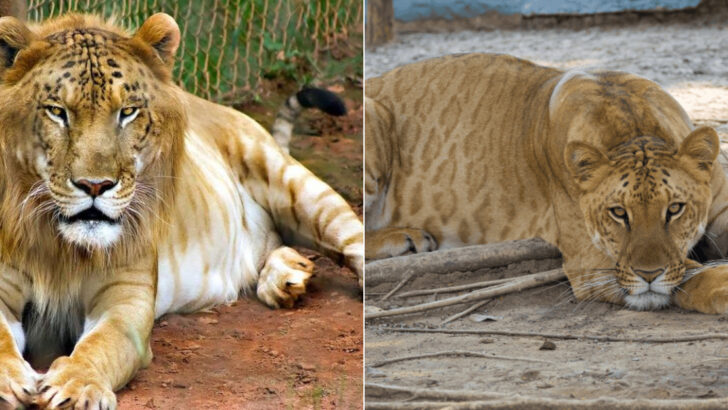When lions and tigers mix, the result isn’t a bedtime story. It’s a real-life mega-cat that looks like it escaped from mythology.
Ligers and tigons aren’t science fiction. They’re massive, mysterious, and rare enough to make even seasoned zookeepers do a double take. Think lion-sized muscle meets tiger stripes—with personalities just as wild as their looks.
These hybrid beasts don’t exist in the wild. They’re born where humans and curiosity collide—usually in captivity, sometimes by accident, and always with a dose of controversy.
They can weigh twice as much as a lion, purr like house cats, and some even enjoy swimming. That’s right. Swimming cats the size of a small car.
You’ve heard the names. Now it’s time to meet the legends. Let’s dive into the strange, spectacular world of ligers and tigons. It’s weirder (and cooler) than you think.
The Liger’s Gigantic Size

With its astonishing stature, the liger stands as the world’s largest cat. Towering over its lion and tiger parents, it can weigh up to 900 pounds. Imagine a creature so large, it seems almost mythical.
This hybrid marvel results from the pairing of a male lion and a female tiger. Ligers typically grow larger than either parent species, showcasing nature’s curious side. Their immense size, combined with gentle demeanor, creates an awe-inspiring presence in animal sanctuaries worldwide. Picture standing next to one, feeling its warm breath and admiring its powerful muscles ripple beneath a golden coat.
Tigon’s Unique Features

Tigons, smaller yet equally intriguing, arise from a male tiger and a female lion. Their features are a captivating mix: faint stripes of tigers and subtle manes from lions.
Their eyes might remind you of deep jungle mysteries, carrying a wild, exotic look. Unlike ligers, tigons often stay within the size range of their parents, making them more elusive in nature. Encountering a tigon feels like meeting a legend, its gaze holding centuries of untamed wilderness. This rare blend of feline grace and ferocity makes tigons a unique spectacle.
The Myth of Sterility

Contrary to popular belief, not all hybrids are sterile. While many ligers and tigons face reproductive challenges, some have successfully bred.
This debunks a long-standing myth, showcasing the adaptability and complexity of genetics. Witnessing the playful antics of a liger cub can be a joyful experience, testament to nature’s unpredictability. This phenomenon invites admiration and scientific curiosity, offering a glimpse into the endless possibilities of hybrid vigor. The sight of a tigon mother with her young is a beautiful contradiction to the sterile myth, a gentle reminder of life’s tenacity.
Liger’s Water Affinity

Inheriting its tiger parent’s affinity for water, the liger often enjoys swimming. This behavior adds a fascinating twist to its lion-like appearance.
Imagine a giant cat gracefully paddling through a pond, its powerful paws creating ripples. Observing a liger in water is mesmerizing, showcasing its playful nature and surprising agility. The scene evokes a sense of tranquility and wonder, as this majestic creature finds joy in the simple pleasure of a swim. For ligers, water is more than a habitat—it’s a playground, a stage for their graceful dance.
Tigon’s Roaring Personality

Tigons possess a unique vocal blend, roaring with a mix of both parents’ calls. Their roar is less thunderous than a lion’s yet more vibrant than a tiger’s.
Hearing a tigon roar is an unforgettable experience, its sound resonating with the ancient rhythm of the wild. This striking feature underscores the tigon’s distinct identity, a blend of power and grace. It’s a voice that commands attention, echoing through the forests and reminding us of nature’s incredible diversity. The tigon captivates not just with its appearance but with its unique voice.
Liger’s Gentle Temperament

Despite their massive size, ligers are often described as having a calm and friendly demeanor. Their temperament mirrors the best of both parents: the lion’s social nature and the tiger’s tranquil presence.
Interacting with a liger is akin to playing with a gentle giant, their eyes filled with curiosity rather than aggression. Their size may intimidate, but their soft-hearted nature wins hearts effortlessly. It’s a reminder of the harmony that can arise from diverse origins, where strength meets tenderness in a harmonious blend.
Hybrid Health Challenges

Hybrids like ligers and tigons often face unique health challenges, including growth disorders and shorter lifespans. The genetic mix can result in unexpected health issues.
Caretakers at sanctuaries work tirelessly to ensure these magnificent creatures receive the best care. Witnessing their dedication is heartwarming, as they offer a lifeline to these unusual cats. Despite these challenges, many hybrids lead fulfilling lives, showcasing resilience and adaptability. It’s a poignant reminder of the delicate balance between nature and nurture in the world of hybrids.
Tigon’s Exotic Appearance

Tigons boast an exotic appearance, blending the distinct traits of lions and tigers. Their coats carry faint stripes, complemented by a small mane, creating a striking look.
This visual fusion is a testament to the intriguing possibilities of hybridization. Seeing a tigon up close is like gazing into an artist’s masterpiece, each stripe a brushstroke of nature’s design. Their exotic charm captivates all, a living canvas of wild elegance. This unique blend of features makes the tigon a photogenic wonder, perfect for those seeking to capture nature’s artistry.
Liger’s Social Behavior

Ligers often display social behaviors inherited from their lion parent, enjoying the company of their own kind and sometimes humans.
Watching a group of ligers interact is like witnessing a majestic ballet, each move deliberate and graceful. Their interactions are filled with playful nudges and gentle roars, embodying a sense of community. For animal lovers, observing their social dynamics offers insights into the complex behaviors of hybrid animals. It’s a unique spectacle of camaraderie and affection, proving that even in the animal kingdom, companionship is cherished.
Tigon’s Elusiveness in the Wild

Unlike ligers, tigons are rarely found in the wild, adding to their mysterious allure. Their elusive nature makes them hard to study in their natural habitat.
This rarity enhances their mythical status, as sightings are few and far between. Imagine the thrill of spotting a tigon in the wild, a fleeting glimpse of a creature that seems to belong to a different world. Their secretive behavior invites intrigue, making them a subject of fascination for researchers and wildlife enthusiasts alike. The tigon remains an enigmatic presence, a hidden gem of nature.
Liger’s Captivating Eyes

The eyes of a liger are a window to its soul, captivating and intense. They combine the piercing gaze of a tiger with the expressive eyes of a lion.
Looking into a liger’s eyes is like peering into a deep, ancient forest, full of secrets and stories. Their gaze holds a regal quality, a reflection of their majestic lineage. For those fortunate enough to see them up close, there’s an undeniable sense of connection. It’s as if these creatures communicate with a silent language, speaking through the depth of their eyes.
Tigon’s Conservation Significance

Tigons, like their liger counterparts, highlight important conservation issues. Their existence raises awareness about habitat loss and the importance of preserving biodiversity.
Conservation efforts strive to protect these unique hybrids, ensuring they continue to inspire awe and curiosity. Visiting a conservation park, you’ll find tigons serving as ambassadors for wildlife education. Their presence invites reflection on the impact of human activities on nature. Protecting tigons is about more than saving a species; it’s about cherishing the intricate web of life that makes our planet so extraordinary.

